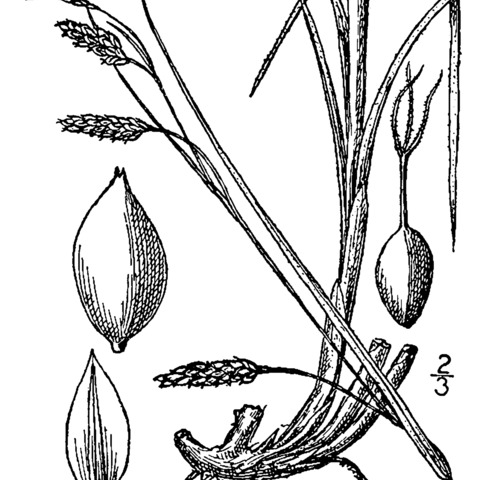Plants densely cespitose. Culms dark maroon at base; flowering stems 0.5–1 mm thick, 30–80 cm, longer than leaves at maturity, glabrous but scabrous on angles within inflorescence. Leaves: basal sheaths maroon, bladeless, pubescent, sometimes glabrous, others grading from marooon to green on back, white-hyaline, red dotted, and pilose on front; blades flat, 3–7 mm wide, glabrous on adaxial surface, pilose on abaxial surface and margins. Inflorescences: ; peduncles of lateral spikes slender, to 10 cm, usually much longer than spikes, pubescent; of terminal spikes 25–50 mm, pubescent; proximal bracts nearly equaling but usually not exceeding inflorescences; sheaths 35–85 mm; blades 2.5–4.5 mm wide. Lateral spikes 2–4, 1 per node, well separated, drooping at maturity, pistillate except for 1 or 2 basal staminate flowers in each, with 8–25 perigynia per spike attached 1 mm apart, cylindric, 15–25 × 4–6 mm. Terminal spike gynecandrous, 15–30 × 5–6 mm in distal pistillate portion, 1.5–2 mm wide in proximal staminate portion. Pistillate scales pale hyaline tinged with chestnut brown, broad green midrib red dotted, ovate, shorter than mature perigynia, apex acute to cuspidate, awn less than 1 mm, glabrous. Perigynia green, copiously red dotted, 2-ribbed with 7–12 fine veins on each face, loosely enveloping achene, ovoid-ellipsoid, 3.5–5 × 1.7–2 mm, membranous, base with short stipe, apex narrowing to abrupt beak, glabrous; beak minutely bidentate, less than 0.5 mm. Achenes substipitate, 2–2.5 × 1.4–1.5 mm.
More
Tufted, 3–7 dm, strongly purplish at base; main lvs 3–7 mm wide, hairy beneath; sheaths hairy at least on the back; terminal spike with a few distal perigynia; lateral spikes pistillate, with a few basal staminate fls, well separated, cylindric, 1–3 cm × 5 mm, densely many-fld, erect or spreading, on peduncles about as long; bracts all sheathing, the uppermost much reduced; pistillate scales ovate to obovate, slightly shorter than the perigynia, obtuse to acuminate or cuspidate; perigynia ovoid, 4–5 mm, half as wide, obscurely trigonous, sharply several-nerved, acuminately narrowed to a distinct short beak; achene sharply and concavely trigonous. Moist soil in woods and thickets; Mass., Conn. and s. Que. to Mich., Wis., and N.D.

